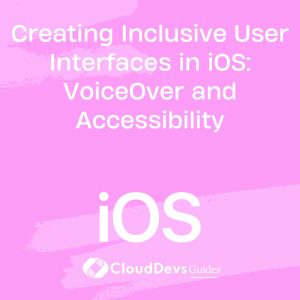Creating Inclusive User Interfaces in iOS: VoiceOver and Accessibility
In today’s digital age, inclusivity isn’t just a buzzword; it’s a necessity. As technology becomes increasingly integrated into our daily lives, it’s crucial to ensure that everyone, regardless of their abilities, can access and interact with digital content. This is where accessibility features like VoiceOver in iOS come into play, revolutionizing the way individuals with visual impairments navigate and use their devices.
Understanding Accessibility in iOS
Accessibility features in iOS are designed to make iPhones and iPads usable by people with various disabilities, including visual, auditory, and motor impairments. Among these features, VoiceOver stands out as a powerful tool for users with vision challenges.
VoiceOver: A Game-Changer for Accessibility
VoiceOver is a built-in screen reader that describes aloud what appears on the screen, allowing users to navigate their device through touch and audio cues. With VoiceOver enabled, individuals can interact with apps, browse the web, and perform tasks on their iOS devices independently.
Designing for Accessibility: Best Practices
Creating inclusive user interfaces in iOS requires developers to implement design principles that prioritize accessibility from the outset. Here are some best practices to keep in mind:
1. Semantic Markup and Labels
Utilize semantic markup and provide descriptive labels for all interface elements. This ensures that VoiceOver can accurately convey the purpose and functionality of each element to users.
2. Proper Use of Accessibility Traits
iOS offers a range of accessibility traits that developers can assign to UI elements to enhance their usability with VoiceOver. For example, marking buttons as “button” and headings as “header” helps users understand the context and structure of the content.
3. Keyboard Navigation
In addition to touch gestures, ensure that your app supports keyboard navigation for users who may have difficulty using touchscreens. Define logical tab orders and provide keyboard shortcuts for common actions to improve accessibility.
4. Contrast and Text Legibility
Pay attention to color contrast and text legibility to ensure that content is readable for users with low vision or color blindness. Use high-contrast colors and avoid relying solely on color to convey information.
Real-World Examples of Inclusive Design
Let’s take a look at some iOS apps that have successfully implemented inclusive design principles, making them accessible to a wide range of users:
1. Microsoft Seeing AI
Seeing AI is an innovative app developed by Microsoft that leverages AI technology to assist users with visual impairments. With features like object recognition, document reading, and scene description, Seeing AI empowers users to explore the world around them through audio feedback.
2. Voice Dream Reader
Voice Dream Reader is a versatile reading app that caters to users with dyslexia, visual impairments, and other reading challenges. It supports various file formats and offers customizable text-to-speech settings, allowing users to personalize their reading experience.
3. Be My Eyes
Be My Eyes connects visually impaired users with sighted volunteers through live video calls, enabling real-time assistance with tasks like reading labels, navigating unfamiliar environments, and identifying objects. This collaborative app fosters a sense of community and mutual support among users worldwide.
Conclusion
Incorporating accessibility features like VoiceOver into iOS apps is not just a matter of compliance; it’s a commitment to inclusivity and equal access to technology for all. By following best practices and learning from real-world examples, developers can create user interfaces that empower individuals with disabilities to fully participate in the digital world.
Remember, accessibility isn’t just a feature—it’s a mindset that drives innovation and fosters a more inclusive society.
So, let’s design with empathy, build with intention, and together, let’s make the digital world a more inclusive place for everyone.
Table of Contents









